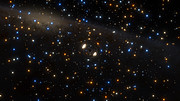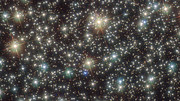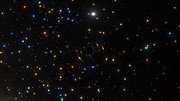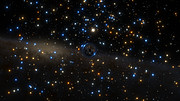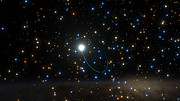Hubble image of the globular star cluster NGC 3201 (annotated)
Hubble image of the globular star cluster NGC 3201 (annotated)
Wide-field image of the sky around the globular star cluster NGC 3201
The globular cluster NGC 3201
Hubble image of the globular star cluster NGC 3201 (unannotated)
The globular cluster NGC 3201 in the constellation of Vela (The Sails)
Video
Notes
[1] The star found is a main sequence turn-off star, meaning it is at the end of the main sequence phase of its life. Having exhausted its primary hydrogen fuel supply it is now on the way to becoming a red giant.
Benjamin Giesers
Georg-August-Universität Göttingen
Göttigen, Germany
Email: giesers@astro.physik.uni-goettingen.de
Stefan Dreizler
Georg-August-Universität Göttingen
Göttigen, Germany
Email: dreizler@astro.physik.uni-goettingen.de
Richard Hook
ESO Public Information Officer
Garching bei München, Germany
Tel: +49 89 3200 6655
Cell: +49 151 1537 3591
Email: rhook@eso.org
ESOcast 146 Light: Odd Behaviour of Star Reveals Black Hole in Giant Star Cluster (4K UHD)
Zooming in on the globular star cluster NGC 3201
Artist’s impression video of the black hole binary system in NGC 3201
Artist’s impression video of the black hole binary system in NGC 3201
Artist’s impression video of the black hole binary system in NGC 3201
Astronomers using ESO’s MUSE instrument
on the Very Large Telescope in Chile have discovered a star in the
cluster NGC 3201 that is behaving very strangely. It appears to be
orbiting an invisible black hole with about four times the mass of the
Sun — the first such inactive stellar-mass black hole found in a
globular cluster and the first found by directly detecting its
gravitational pull. This important discovery impacts on our
understanding of the formation of these star clusters, black holes, and
the origins of gravitational wave events.
Globular star clusters
are huge spheres of tens of thousands of stars that orbit most
galaxies. They are among the oldest known stellar systems in the
Universe and date back to near the beginning of galaxy growth and
evolution. More than 150 are currently known to belong to the Milky Way.
One particular cluster, called NGC 3201 and situated in the southern constellation of Vela (The Sails), has now been studied using the MUSE instrument on ESO’s Very Large Telescope in Chile. An international team of astronomers has found that one of the stars [1]
in NGC 3201 is behaving very oddly — it is being flung backwards and
forwards at speeds of several hundred thousand kilometres per hour, with
the pattern repeating every 167 days [2].
Lead author Benjamin Giesers (Georg-August-Universität Göttingen, Germany) was intrigued by the star’s behaviour: “It
was orbiting something that was completely invisible, which had a mass
more than four times the Sun — this could only be a black hole! The
first one found in a globular cluster by directly observing its
gravitational pull.”
The relationship between black holes and globular clusters
is an important but mysterious one. Because of their large masses and
great ages, these clusters are thought to have produced a large number
of stellar-mass black holes — created as massive stars within them exploded and collapsed over the long lifetime of the cluster [3][4].
ESO’s MUSE instrument provides astronomers with a unique
ability to measure the motions of thousands of far away stars at the
same time. With this new finding, the team have for the first time been
able to detect an inactive black hole at the heart of a globular cluster
— one that is not currently swallowing matter and is not surrounded by a
glowing disc of gas. They could estimate the black hole’s mass through
the movements of a star caught up in its enormous gravitational pull [5].
From its observed properties the star was determined to be
about 0.8 times the mass of our Sun, and the mass of its mysterious
counterpart was calculated at around 4.36 times the Sun’s mass — almost
certainly a black hole [6].
Recent detections of radio and X-ray sources in globular
clusters, as well as the 2016 detection of gravitational-wave signals
produced by the merging of two stellar-mass black holes, suggest that
these relatively small black holes may be more common in globular
clusters than previously thought.
Giesers concludes: “Until recently, it was assumed that
almost all black holes would disappear from globular clusters after a
short time and that systems like this should not even exist! But clearly
this is not the case — our discovery is
the first direct detection of the gravitational effects of a
stellar-mass black hole in a globular cluster. This finding helps in understanding
the formation of globular clusters and the evolution of black holes and
binary systems — vital in the context of understanding gravitational
wave sources.”
Notes
[1] The star found is a main sequence turn-off star, meaning it is at the end of the main sequence phase of its life. Having exhausted its primary hydrogen fuel supply it is now on the way to becoming a red giant.
[2] A large survey of 25
globular clusters around the Milky Way is currently being conducted
using ESO’s MUSE instrument with the support of the MUSE consortium. It
will provide astronomers with the spectra of 600 to 27 000 stars in each
cluster. The study includes analysis of the “radial velocity” of
individual stars — the speed at which they move away from and toward the
Earth, along the line of sight of the observer. With radial velocity
measurements the orbits of stars can be determined, as well as the
properties of any massive object they may be orbiting.
[3] In the absence of
continuous star formation, as is the case for globular clusters,
stellar-mass black holes soon become the most massive objects present.
Generally, stellar-mass black holes in globular clusters are about four
times as massive as the surrounding low-mass stars. Recent theories have
concluded that black holes form a dense nucleus within the cluster,
which then becomes detached from the rest of the globular material.
Movements at the centre of the cluster are then thought to eject the
majority of black holes, meaning only a few would survive after a
billion years.
[4] Stellar-mass black holes — or collapsars — are formed when massive stars die, collapsing under their own gravity and exploding as powerful hypernovae.
Left behind is a black hole with most of the mass of the former star,
which can range from a few times the mass of our Sun to several tens of
times as massive.
[5] As no light is able to
escape black holes because of their tremendous gravity, the primary
method of detecting them is through observations of radio or X-ray
emissions coming from hot material around them. But when a black hole is
not interacting with hot matter and so not accumulating mass or
emitting radiation, as in this case, the black hole is “inactive” and
invisible, so another method of detection is required.
[6] Because the non-luminous
object in this binary system cannot be directly observed there are
alternative, although much less persuasive, explanations for what it
could be. It is perhaps a triple star system made up of two tightly
bound neutron stars, with the observed star orbiting around them. This
scenario would require each tightly bound star to be at least twice the
mass of our Sun, a binary system that has never been observed before.
More Information
More Information
This research was presented in a paper entitled “A detached
stellar-mass black hole candidate in the globular cluster NGC 3201”, by
B. Giesers et al., to appear in the journal Monthly Notices of the Royal Astronomical Society.
The team is composed of Benjamin Giesers (Georg-August-Universität Göttingen, Germany), Stefan Dreizler (Georg-August-Universität Göttingen, Germany), Tim-Oliver Husser (Georg-August-Universität Göttingen, Germany), Sebastian Kamann (Georg-August-Universität Göttingen, Germany; Liverpool John Moores University, Liverpool, United Kingdom), Guillem Anglada Escudé (Queen Mary University of London, United Kingdom), Jarle Brinchmann (Leiden Observatory, Leiden University, Leiden, The Netherlands; Universidade do Porto, CAUP, Porto, Portugal), C. Marcella Carollo (Swiss Federal Institute of Technology, ETH, Zurich, Switzerland) Martin M. Roth (Leibniz-Institut für Astrophysik Potsdam, Potsdam, Germany), Peter M. Weilbacher (Leibniz-Institut für Astrophysik Potsdam, Potsdam, Germany) and Lutz Wisotzki (Leibniz-Institut für Astrophysik Potsdam, Potsdam, Germany).
ESO is the foremost intergovernmental astronomy organisation in Europe and the world’s most productive ground-based astronomical observatory by far. It is supported by 16 countries: Austria, Belgium, Brazil, the Czech Republic, Denmark, France, Finland, Germany, Italy, the Netherlands, Poland, Portugal, Spain, Sweden, Switzerland and the United Kingdom, along with the host state of Chile and by Australia as a strategic partner. ESO carries out an ambitious programme focused on the design, construction and operation of powerful ground-based observing facilities enabling astronomers to make important scientific discoveries. ESO also plays a leading role in promoting and organising cooperation in astronomical research. ESO operates three unique world-class observing sites in Chile: La Silla, Paranal and Chajnantor. At Paranal, ESO operates the Very Large Telescope and its world-leading Very Large Telescope Interferometer as well as two survey telescopes, VISTA working in the infrared and the visible-light VLT Survey Telescope. ESO is also a major partner in two facilities on Chajnantor, APEX and ALMA, the largest astronomical project in existence. And on Cerro Armazones, close to Paranal, ESO is building the 39-metre Extremely Large Telescope, the ELT, which will become “the world’s biggest eye on the sky”.
The team is composed of Benjamin Giesers (Georg-August-Universität Göttingen, Germany), Stefan Dreizler (Georg-August-Universität Göttingen, Germany), Tim-Oliver Husser (Georg-August-Universität Göttingen, Germany), Sebastian Kamann (Georg-August-Universität Göttingen, Germany; Liverpool John Moores University, Liverpool, United Kingdom), Guillem Anglada Escudé (Queen Mary University of London, United Kingdom), Jarle Brinchmann (Leiden Observatory, Leiden University, Leiden, The Netherlands; Universidade do Porto, CAUP, Porto, Portugal), C. Marcella Carollo (Swiss Federal Institute of Technology, ETH, Zurich, Switzerland) Martin M. Roth (Leibniz-Institut für Astrophysik Potsdam, Potsdam, Germany), Peter M. Weilbacher (Leibniz-Institut für Astrophysik Potsdam, Potsdam, Germany) and Lutz Wisotzki (Leibniz-Institut für Astrophysik Potsdam, Potsdam, Germany).
ESO is the foremost intergovernmental astronomy organisation in Europe and the world’s most productive ground-based astronomical observatory by far. It is supported by 16 countries: Austria, Belgium, Brazil, the Czech Republic, Denmark, France, Finland, Germany, Italy, the Netherlands, Poland, Portugal, Spain, Sweden, Switzerland and the United Kingdom, along with the host state of Chile and by Australia as a strategic partner. ESO carries out an ambitious programme focused on the design, construction and operation of powerful ground-based observing facilities enabling astronomers to make important scientific discoveries. ESO also plays a leading role in promoting and organising cooperation in astronomical research. ESO operates three unique world-class observing sites in Chile: La Silla, Paranal and Chajnantor. At Paranal, ESO operates the Very Large Telescope and its world-leading Very Large Telescope Interferometer as well as two survey telescopes, VISTA working in the infrared and the visible-light VLT Survey Telescope. ESO is also a major partner in two facilities on Chajnantor, APEX and ALMA, the largest astronomical project in existence. And on Cerro Armazones, close to Paranal, ESO is building the 39-metre Extremely Large Telescope, the ELT, which will become “the world’s biggest eye on the sky”.
Benjamin Giesers
Georg-August-Universität Göttingen
Göttigen, Germany
Email: giesers@astro.physik.uni-goettingen.de
Stefan Dreizler
Georg-August-Universität Göttingen
Göttigen, Germany
Email: dreizler@astro.physik.uni-goettingen.de
Richard Hook
ESO Public Information Officer
Garching bei München, Germany
Tel: +49 89 3200 6655
Cell: +49 151 1537 3591
Email: rhook@eso.org
Source: ESO






